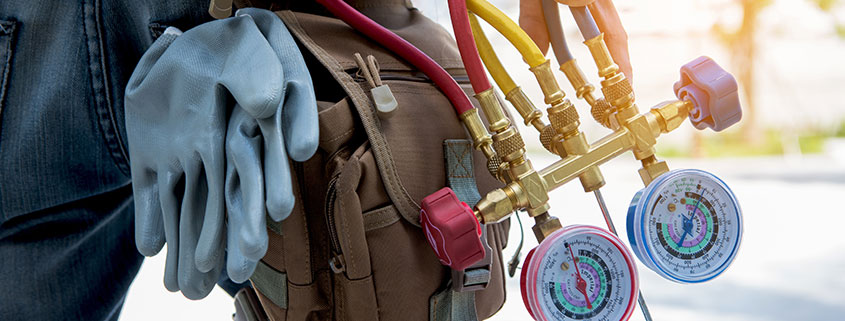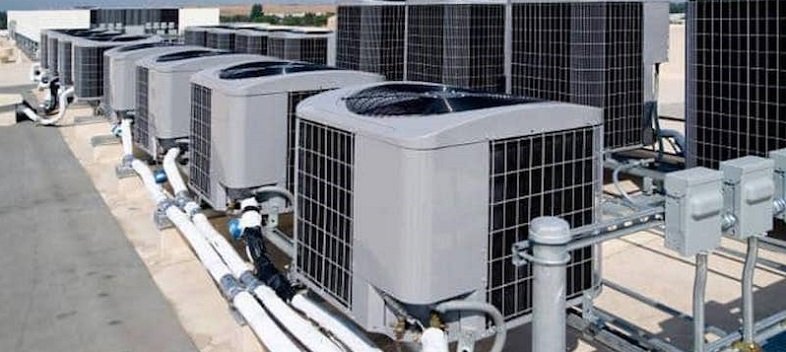Essential Insights About ductless mini splits Before You Upgrade
Essential Insights About ductless mini splits Before You Upgrade
Blog Article
Just How a Heat Pump and Furnace Collaborate to Enhance Your Home's Heating Performance
Comprehending how a warmth pump and heater interact is important for home owners looking for efficient heating services. Each system has its strengths, providing a balanced technique to home convenience. The heat pump stands out in moderate temperature levels, while the heater provides rapid warmth during severe cold. This synergy not only minimizes power expenses yet likewise improves the life-span of both appliances. What aspects influence this partnership, and exactly how can property owners maximize their benefits?
Understanding Heat Pumps: Just How They Work
Although numerous individuals might be unknown with their internal operations, heatpump play a vital duty in contemporary heating unit. These tools operate by moving heat from one location to one more, using the principles of thermodynamics. In cooler months, a heatpump removes heat from the outside air, ground, or water, and transfers it indoors to warm the space. Alternatively, throughout warmer months, it can turn around the procedure, serving as an air conditioning unit by removing warmth from inside to the outside.Heat pumps include an evaporator, compressor, expansion, and condenser shutoff. The cooling agent within the system soaks up warm as it evaporates at reduced temperatures and pressures. The compressor then enhances the stress and temperature level of the cooling agent, permitting it to launch heat as it condenses. This reliable process can considerably reduce power usage contrasted to typical home heating techniques, making heatpump a sustainable selection for climate control in homes.
The Function of Heaters in Home Home Heating
Heaters play an important function in home heating by offering a trusted resource of heat throughout the chillier months. They run by producing warmth through burning or electric resistance, dispersing it throughout the home using air ducts or radiant systems. The effectiveness of a furnace is often gauged by its Annual Gas Utilization Effectiveness (AFUE) rating, which shows just how successfully the device converts fuel into heat.Furnaces can use different power sources, including gas, propane, oil, or power, enabling house owners to choose the most suitable choice for their needs. Unlike heatpump, which may struggle in extreme cold, heaters keep consistent performance, guaranteeing that interior temperature levels stay comfy regardless of exterior problems. Furthermore, modern furnaces often come equipped with sophisticated technology, such as variable-speed blowers and wise thermostats, boosting their efficiency and responsiveness. This adaptability makes heaters a crucial part in all-inclusive home heating methods.

Advantages of Using Both Equipments With Each Other
Integrating the strengths of both heaters and warm pumps can cause an extra effective and effective home heating solution. Making use of both systems allows property owners to take benefit of the warm pump's energy performance throughout milder temperature levels while counting on the heating system for more severe cold conditions. This dual technique can substantially lower power costs, as heatpump eat much less power than traditional heating methods when temperatures are moderate.Additionally, utilizing both systems together can enhance comfort levels in the home. Heatpump can offer consistent, also heating, while heating systems can promptly increase ambient temperature levels when needed. The combination of both systems can prolong the life expectancy of tools by lowering wear and tear on each unit, as they share the workload. Inevitably, home owners can delight in a balanced, economical home heating service that readjusts flawlessly to varying weather, making sure a cozy and inviting home throughout the cold weather.
Exactly How Heat Pumps and Furnaces Complement Each Other
They develop a corresponding heating system that makes the most of effectiveness and comfort when home owners incorporate warm pumps and heating systems. Heatpump operate by moving heat from the outside air or ground, making them extremely effective in moderate environments. They succeed throughout milder temperatures, providing cost-effective home heating. Conversely, heaters produce warmth through combustion or electric resistance, providing strong, immediate heat during severe cool conditions.The combination of these two systems enables vibrant changes based on temperature fluctuations. During warmer months or milder winter season days, the heatpump can take the lead, conserving power and minimizing expenses. As temperature levels decline, the furnace can seamlessly engage, ensuring regular heat throughout the home. This synergy not just optimizes power usage yet additionally boosts the life-span of both systems, as each device runs within its perfect efficiency range. Together, they create a well balanced setting that adjusts to varying environment demands.
Enhancing Performance: Tips for Homeowners
Property owners can boost their home heating effectiveness via several practical techniques. Establishing a routine maintenance routine, incorporating clever thermostat technology, and applying reliable insulation and sealing services are crucial steps. These measures not only improve comfort however additionally lower energy expenses.
Regular Maintenance Set Up
To assure maximum home heating performance, developing a regular upkeep routine is crucial for any kind of home. House owners need to prioritize routine inspections of both heat pumps and heaters to identify peak efficiency. This includes transforming air filters each to three months, as stopped up filters can substantially decrease performance. Furthermore, scheduling expert maintenance a minimum of as soon as a year allows specialists to determine and deal with potential problems before they rise. Homeowners should also clean up the heat pump's outside system to protect against particles buildup that can hinder airflow. By sticking to a regular maintenance timetable, home owners not just boost their furnace' effectiveness yet additionally extend their life expectancy, leading to greater comfort and minimized power prices throughout the colder months.
Smart Thermostat Assimilation
Incorporating a wise thermostat right into a home furnace can greatly improve energy efficiency, specifically as it enables for precise control over temperature level settings. These devices can find out the home owner's routine and preferences, automatically adjusting the temperature level to enhance convenience while minimizing power usage. As an example, they can lower heating during times when the home is empty, lowering unneeded consumption. Many clever thermostats also give real-time power use information, enabling home owners to make informed decisions concerning their heating practices. In addition, remote access via smartphone apps allows customers to readjust setups from anywhere, making certain the home is warm upon return. Overall, clever thermostat assimilation not only improves comfort however substantially contributes to power financial savings and effectiveness.
Insulation and Securing Solutions
Smart thermostats play a vital function in energy performance, yet their performance can be substantially boosted additional resources by proper insulation and sealing options. Property owners need to focus on insulating walls, attic rooms, and floorings to minimize heat loss. High-quality insulation materials, such as spray foam or fiberglass, can significantly improve thermal resistance. In addition, sealing voids around ducts, windows, and doors prevents cold air infiltration and warm retreat. Weatherstripping and caulking are reliable approaches for addressing these leakages - furnace replacement. Regular assessments for air leakages, in addition to making use of blower door examinations, can help recognize problem locations. By purchasing insulation and securing, property owners can enhance the efficiency of their heating unit, eventually resulting in decreased power usage and lower energy bills
Typical Myths About Warmth Pumps and Furnaces
What false impressions surround warm pumps and heating systems? Several individuals wrongly believe that heatpump are inadequate in cooler climates. In truth, modern heatpump are created to run successfully also in low temperature levels, giving dependable heating throughout wintertime. One more usual misconception is that heating systems are constantly a lot more efficient than heatpump. This depends on the specific power sources and effectiveness scores of the units in concern. Some may additionally think that making use of both systems simultaneously is unneeded, but in truth, this combination can enhance home heating efficiency, particularly during severe weather. Furthermore, individuals often presume that heat pumps call for continuous maintenance, when actually, they have similar maintenance requires to typical heating unit. By disproving these misconceptions, property owners can make even more enlightened decisions concerning their home heating choices, inevitably causing enhanced comfort and energy efficiency in their homes.
Upkeep Considerations for Combined Solutions

Regularly Asked Inquiries
Can Warmth Pumps Job Properly in Very Cold Climates?
Heat pumps can have a hard time in exceptionally chilly environments because of reduced performance and warm extraction constraints. Advancements in innovation have actually led to models created for far better efficiency in such conditions, boosting their practicality in extreme environments.
How Lengthy Do Warm Pumps and Furnaces Usually Last?
Warm pumps commonly last 15 to twenty years, while heaters have a lifespan of 15 to 30 years. Routine maintenance can extend their long life, guaranteeing reliable operation and minimizing the demand for premature substitutes.

What Is the Typical Expense of Installing Both Solutions?
The typical expense of setting up both a warmth pump and a furnace commonly ranges between $5,000 to $10,000 - ductless mini splits. Aspects influencing this expense include system dimension, installation intricacy, and regional labor rates
Are There Tax Obligation Motivations for Utilizing Energy-Efficient Heating Solutions?
Lots of home owners make inquiries about tax incentives for energy-efficient heating unit. Different government and state programs frequently provide discounts or credit histories, encouraging the adoption of sustainable technologies to reduce energy consumption and advertise environmental obligation.
Exactly how Do I Pick the Right Dimension Heat Pump and Heater?
Selecting the appropriate size heatpump and furnace involves computing the home's square video, taking into consideration insulation top quality, and evaluating regional climate. Consulting a professional can ensure excellent system efficiency and energy effectiveness based upon particular demands. ductless mini splits. Understanding just how a warmth pump and furnace work with each other is necessary for homeowners looking for effective home heating options. In colder months, a heat pump extracts warmth from the outdoors air, ground, or water, and transfers it inside your home to heat the living area. When house owners incorporate heat pumps and furnaces, they create a complementary home heating system that maximizes performance and Homepage comfort. Warmth pumps operate by transferring heat from the outside air or ground, making them very efficient in modest climates. Heat pumps can struggle in very Continue cool environments due to decreased performance and warm extraction limitations
Report this page